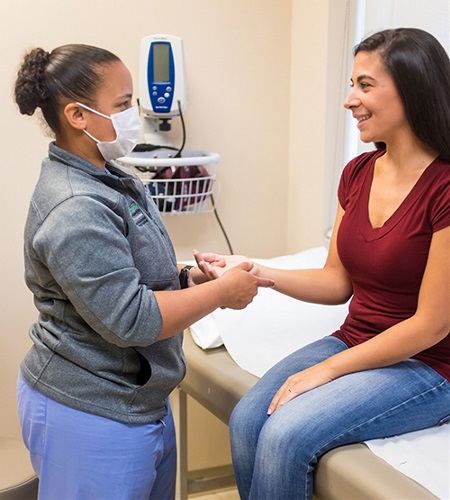Lauren Kevorkian is the mom of two young children in the Midlands. She jokes that it wasn’t her newborn baby who kept her up at night — it was the pain in her right hand.
“The numbness and tingling were terrible. It started with my ring finger and pinkie finger. And there was pain through the meaty muscle on my thumb,” she said.
The pain was the result of carpal tunnel syndrome, which occurs when there’s pressure on the median nerve as it moves through a narrow passageway near the wrist called the carpal tunnel. When the median nerve compresses as it passes through the carpal tunnel, the symptoms can include numbness, tingling, pain and weakness in the hand and arm.
Lauren’s symptoms first appeared during pregnancy, a common occurence in women who may also experience swelling in their hands, feet and ankles. Swelling can also take up room in the carpal tunnel and cause issues, even for women who never had symptoms in the past.
Lauren’s symptoms persisted after her baby was born. They kept her up at night, and the aches and pains eventually began occurring during the day, too.
At first, she tried taking a cortisone shot and wearing a brace on her hand to help alleviate the pain, which worked for a short while, but the pain always returned. “It bothered me so much, I had to do something.”
Lauren made an appointment to see Andrea L. Gale, MD, an orthopaedic hand surgeon with Lexington Orthopaedics and Sports Medicine. Lauren thought perhaps another cortisone shot would alleviate her pain. But while cortisone injections have an important role in providing relief from carpal tunnel symptoms, Dr. Gale said the injections don’t always address mechanical problems.

Dr. Andrea Gale examining Lauren's hand.
“With most pregnancy-induced cases, carpal tunnel syndrome goes away when swelling resolves. But in Lauren’s case, the symptoms persisted,” Dr. Gale said. “So, at that point, I advised her that releasing the pressure was the best bet for long-term recovery.”
That recovery meant surgery with a simple, inch-long incision in the palm.
“Right underneath that skin, under a little layer of muscle, is the ligament that pushes on that nerve. Basically, you cut that ligament into two sections so it opens like a drawbridge. Right underneath that ligament is the nerve. Most of the time, you’ll see a little impression in that nerve where the pressure had been building,” Dr. Gale said. “You can almost see a release at the time of surgery and see that ligament swing open.”

Patients who don’t have severe carpal tunnel syndrome can notice relief almost immediately after surgery. For severe cases, recovery can take up to a year, however most people are back to normal activity within six weeks.
For Lauren, the surgery provided instant relief from the numbness and tingling.
“Dr. Gale and her team were wonderful, thorough and supportive,” Lauren said.
The soreness from the surgery lasted only a few days, and she resumed activities quickly.
“I just had a friend tell me she thinks she has carpal tunnel syndrome. I told her to go ahead and have the surgery. I waited a long time before I did it. I was worried about the down time,” she said. “But I was able to write with a pencil within a week. It was worth it.”

Andrea L. Gale, MD, Lexington Orthopaedics and Sports Medicine



.jpg?sfvrsn=35486c0a_0)


Leave a comment